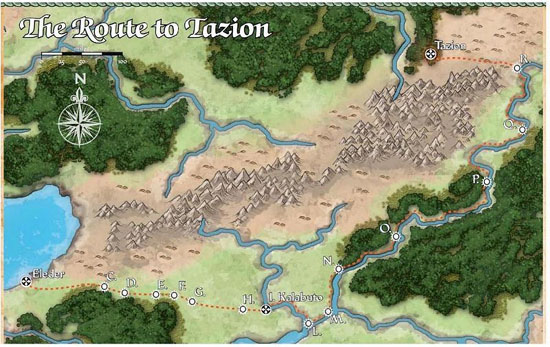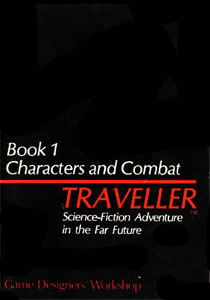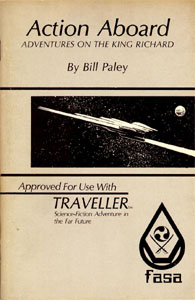Go to Part 1
Now that we’ve discussed incomplete game structures, let me go fully the wrong way about it and explain what I mean by a “complete game structure”.
Most importantly, what I do not mean by a complete game structure is that the players will never be able to take actions outside the structure. As I’ve been saying all along, roleplaying games are functionally open-ended: Unlike a boardgame or card game, players are always free to propose whatever course of action strikes their fancy.
Instead, what we’re talking about is a structure which can theoretically provide a complete experience. If the players choose to stick to a complete game structure, that structure will never deliver the game to a place where no structure exists.
Practical experience at the game table plays a role here, and I’m also expecting a dose of common sense: It’s possible to argue that Traveller presents a “complete game structure” as long as the PCs never leave their ships. But, of course, that’s not what actually happens at the game table, is it? What happens in actual practice is that the Traveller scenario structure delivers a ship to a starport, the PCs get off their ship, and… the scenario structure has delivered them to an unstructured place.
In practice, complete game structures require vertically integrated structures and closed resolution loops. They will also usually feature complete transitions from macro-level to micro-level game structures.
For example, consider the basic mystery scenario structure: You start in a location and you search for clues. The clues take you to another location, where you search for clues (which will, of course, take you to another location).
That’s a closed resolution loop: You can follow that structure forever.
Earlier, we talked about the smooth transition from dungeoncrawling to combat in D&D: You’re in a dungeon room, you pick an exit, and you go to another dungeon room (there’s your closed resolution loop). But in that room are a bunch of monsters, so you switch to the combat system (which is another closed resolution loop) until you defeat the monsters. Once the combat is finished, you swap back to the dungeoncrawl structure, pick an exit, and go to the next room (which might also have monsters in it, in which case you swap back into combat).
That’s a vertically integrated structure: The dungeoncrawl structure provides a specific trigger (“there are monsters here”) which transitions you into the combat structure; and the combat structure provides a specific trigger (“all the monsters are dead and the room is empty of interest”) which transitions you back into the dungeoncrawl structure.
(As a thought experiment, imagine that you were using a dungeoncrawl structure but you had no combat system. Can you see what happens when the dungeoncrawl delivers you to a room full of orcs? The structure is incomplete. Now, imagine that you’re using a dungeoncrawl structure but instead of a combat system the rules had a well-developed mechanical structure for resolving riddle contests. That’s a very different dungeon, isn’t it?)
It’s also possible to extend the chain of macro-level to micro-level transitions. An easy demonstration of this is a hex keyed with a dungeon complex: The hexcrawl structure triggers the discovery of the dungeon; entering the dungeon transitions you to the dungeoncrawl structure; and meeting some monsters in the dungeon transitions you to the combat structure.
I occasionally think of this as an inverted pyramid, but it’s not necessarily a tidy one. (For example, hex keys can also easily trigger you straight into combat.)
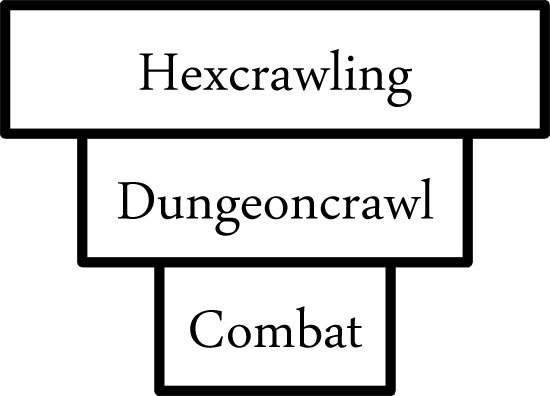
FEATURES OF A COMPLETE GAME STRUCTURE
Let’s take a moment to look at the basic features a complete game structure requires. By matter of necessity, these will be somewhat preliminary conclusions: There aren’t many complete game structures in roleplaying games, so the body of data is sparse.
First, each part of the game structure requires a clear and specific trigger. (For example, combat is triggered when someone wants to make an attack and initiative is rolled.) Vertically integrating your structure requires that the macro-structure will deliver the triggers necessary for the micro-structures. (For example, the dungeoncrawl structure delivers the trigger for combat when you enter a room filled with hostile monsters.)
Second, you need a default scenario hook. This is actually just the trigger for the macro-structure which contains the micro-structures and it doesn’t need to be terribly complex: For example, the default scenario hook for a dungeoncrawl is “the dungeon entrance is in front of you”.
Third, you need a default goal. This is what motivates the players to engage the scenario hook. For example, the PCs go into the dungeon (i.e., accept the hook presented by the dungeon entrance) because they want to find treasure.
(It should be noted that the default scenario hook and goal are often the first things to get swapped out when you’re adapting a game structure into actual play. For example, the PCs might be going into this dungeon – which is actually a fortress – because their friend has been kidnapped by the slavers inside.)
Fourth, you need a default action: Picking an exit in the dungeoncrawl; picking a direction in a hexcrawl; looking for clues in a mystery; attacking an enemy during combat; etc.
Fifth, taking the default action should return you (either directly or after a sequence of actions) to a point where you can take that default action again. This is the point where you close the resolution loop and complete the game structure.
EFFECTIVE GAME STRUCTURES
There are also a few things which aren’t necessarily required for a complete game structure, but which are probably a good idea.
First, the structure should be flexible. Flexibility for the players means the ability to make choices which are not constrained by the structure. Flexibility for the GM means the ability to include a broad and creative array of content into the “containers” of the structure.
(These constitute the “structure, not a straitjacket” and “flexibility within the form” principles we talked about before.)
Second, the default action should usually allow the players to make meaningful decisions. Roleplaying games are primarily about making choices and structures which don’t allow for those choices to be made will, in my opinion, struggle. Furthermore, a structure which doesn’t include points at which players are free to make decisions is probably going to strongly inhibit their opportunities to make choices which are not constrained by the structure (see above).
(As a counterexample, consider a hypothetical piratecrawl structure in which the players choose a direction to sail and then the GM randomly determines what type of ship they run into: This has a great deal of flexibility for the GM, since he’s basically free to include anything which fits into a ship-shaped container. But you’ll notice that the players’ decision of sailing direction is meaningless, which will result in less than satisfactory play.)
Third, assuming that we’re talking about RPGs and not STGs, the players’ decisions within the game structure should be associated and in-character.
(For pretty much all the same reasons that the mechanics of an RPG should be associated.)
Fourth, the reward structures of the game should probably be tied into the default actions and default goals of the game structure.
(The easy example here, as I’ve mentioned before, is D&D: The default dungeoncrawl / combat game structure rewards you with XP for the default action of fighting monsters and with GP (and XP) for the default goal of treasure-hunting.)
Fifth, the game structure should be fun. This, of course, can be a somewhat nebulous quality and will also vary from one group to the next. But the important point here is that a complete game structure will act as the foundation for your scenario or campaign: If that foundation is fun, then everything you and your players build on top of it will be fun. If it is simply workmanlike bookkeeping, on the other hand, you may still end up having fun if the stuff you build on top of it is awesome enough, but it’ll be less of a sure thing.
Sixth, the game structure should be easy to prep. Part of this is providing a clear structure for prep (and I think you’ll find that clearly defined game structures will simultaneously provide straight-forward guidance on what you need to prep). But it’s also about limiting the amount of prep necessary for play to begin. (If your structure requires the GM to prep 500 pages of material in order to use it, it’s not going to see a lot of use in the real world.) And all of this, of course, can be helped by giving the GM tools which assist with prep (like the old dungeon- and hex-stocking tables that used to be a mainstay of D&D).
I was also going to add “easy to run” to this list, but I suspect that this is a quality which actually arises naturally out of properly constructed game structures. But if you’re in need of a reminder, check out Part 8 of this series.
Go to Part 12: Using Scenario Structures
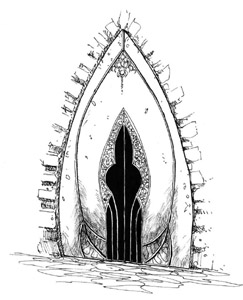 Something I’ve spent literally years struggling with as a GM is transitioning from one scenario structure to another within a dungeoncrawl.
Something I’ve spent literally years struggling with as a GM is transitioning from one scenario structure to another within a dungeoncrawl.
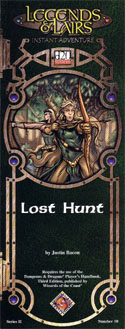 When I designed The Lost Hunt for Fantasy Flight Games, I launched the scenario by having an elven village attacked by a kehtal (a servitor of the demon gods of Keht). The idea was pretty simple: The PCs could then follow the trail of this murderous creature, which would lead them to the interdimensional rift in which the demon gods were imprisoned.
When I designed The Lost Hunt for Fantasy Flight Games, I launched the scenario by having an elven village attacked by a kehtal (a servitor of the demon gods of Keht). The idea was pretty simple: The PCs could then follow the trail of this murderous creature, which would lead them to the interdimensional rift in which the demon gods were imprisoned.

